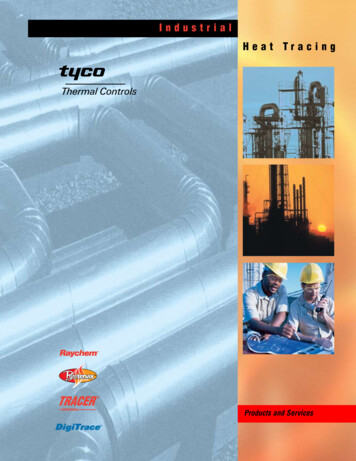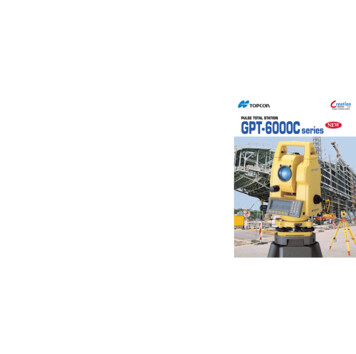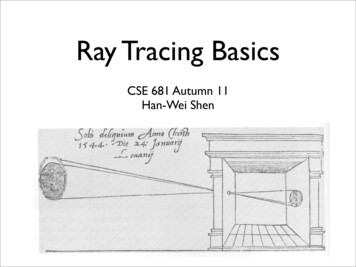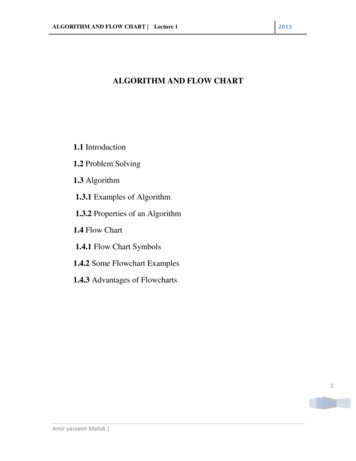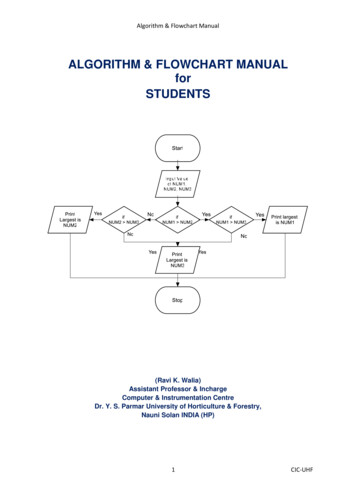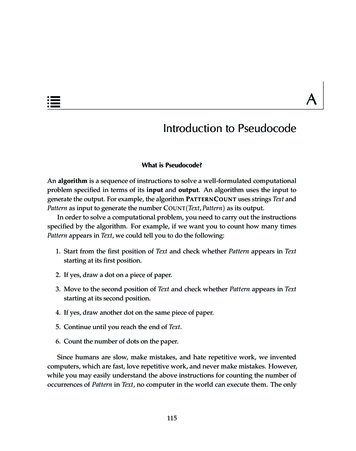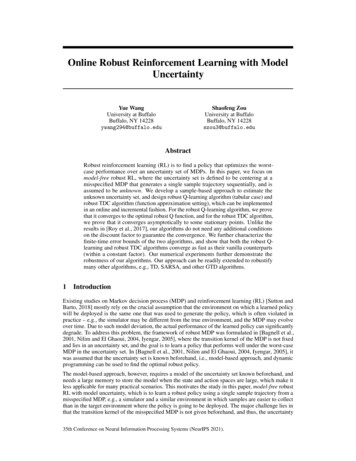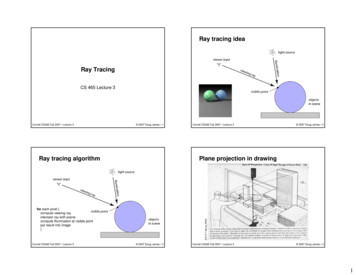
Transcription
Ray tracing ideaRay TracingCS 465 Lecture 3Cornell CS465 Fall 2007 Lecture 3 2007 Doug James 1Ray tracing algorithm 2007 Doug James 2Plane projection in drawing[CS 417 Spring 2002]for each pixel {compute viewing rayintersect ray with scenecompute illumination at visible pointput result into image}Cornell CS465 Fall 2007 Lecture 3Cornell CS465 Fall 2007 Lecture 3 2007 Doug James 3Cornell CS465 Fall 2007 Lecture 3 2007 Doug James 41
Plane projection in photographyGenerating eye rays This is another model for what we are doing Use window analogy directly[CS 417 Spring 2002]– applies more directly in realistic renderingCornell CS465 Fall 2007 Lecture 3 2007 Doug James 5Cornell CS465 Fall 2007 Lecture 3 2007 Doug James 6Vector math reviewRay: a half line Vectors and points Standard representation: point p and direction d Vector operations– addition– scalar product–––– More products– dot product– cross productthis is a parametric equation for the linelets us directly generate the points on the lineif we restrict to t 0 then we have a raynote replacing d with ad doesn’t change ray (a 0) Bases and orthogonalityCornell CS465 Fall 2007 Lecture 3 2007 Doug James 7Cornell CS465 Fall 2007 Lecture 3 2007 Doug James 82
Ray-sphere intersection: algebraicRay-sphere intersection: algebraic Condition 1: point is on ray Solution for t by quadratic formula: Condition 2: point is on sphere– assume unit sphere; see Shirley or notes for general– simpler form holds when d is a unit vectorbut we won’t assume this in practice (reason later)– I’ll use the unit-vector form to make the geometric interpretation Substitute:– this is a quadratic equation in tCornell CS465 Fall 2007 Lecture 3 2007 Doug James 9Ray-sphere intersection: geometricCornell CS465 Fall 2007 Lecture 3 2007 Doug James 10Ray-box intersection Could intersect with 6 faces individually Better way: box is the intersection of 3 slabsCornell CS465 Fall 2007 Lecture 3 2007 Doug James 11Cornell CS465 Fall 2007 Lecture 3 2007 Doug James 123
Ray-slab intersectionIntersecting intersections 2D example Each intersectionis an interval 3D is the same! Want lastentry point andfirst exit pointShirley fig. 10.16Cornell CS465 Fall 2007 Lecture 3 2007 Doug James 13Ray-triangle intersectionCornell CS465 Fall 2007 Lecture 3 2007 Doug James 14Ray-triangle intersection Condition 1: point is on ray In plane, triangle is the intersection of 3 half spaces Condition 2: point is on plane Condition 3: point is on the inside of all three edges First solve 1&2 (ray–plane intersection)– substitute and solve for t:Cornell CS465 Fall 2007 Lecture 3 2007 Doug James 15Cornell CS465 Fall 2007 Lecture 3 2007 Doug James 164
Inside-edge testRay-triangle intersection Need outside vs. inside Reduce to clockwise vs. counterclockwise– vector of edge to vector to x Use cross product to decideCornell CS465 Fall 2007 Lecture 3 2007 Doug James 17Cornell CS465 Fall 2007 Lecture 3Image so farIntersection against many shapes With eye ray generation and sphere intersection The basic idea is: 2007 Doug James 18hit (ray, tMin, tMax) {tBest inf; hitSurface null;for surface in surfaceList {t surface.intersect(ray, tMin, tMax);if t tBest {tBest t;hitSurface surface;}}return hitSurface, t;}Surface s new Sphere((0.0, 0.0, 0.0), 1.0);for 0 iy nyfor 0 ix nx {ray camera.getRay(ix, iy);if (s.intersect(ray, 0, inf) inf)image.set(ix, iy, white);}– this is linear in the number of shapesbut there are sublinear methods (acceleration structures)Cornell CS465 Fall 2007 Lecture 3 2007 Doug James 19Cornell CS465 Fall 2007 Lecture 3 2007 Doug James 205
Image so farShading With eye ray generation and scene intersection Compute light reflected toward camera Inputs:– eye direction– light direction(for each of many lights)– surface normal– surface parameters(color, shininess, )for 0 iy nyfor 0 ix nx {ray camera.getRay(ix, iy);c scene.trace(ray, 0, inf);image.set(ix, iy, c);} More on this in thenext lecture trace(ray, tMin, tMax) {surface, t hit(ray, tMin, tMax);if (surface ! null) return surface.color();else return black;}Cornell CS465 Fall 2007 Lecture 3 2007 Doug James 21Image so farCornell CS465 Fall 2007 Lecture 3 2007 Doug James 22Shadows Surface is only illuminated if nothing blocks its view of thelight.trace(Ray ray, tMin, tMax) {surface, t hit(ray, tMin, tMax);if (surface ! null) {point ray.evaluate(t);normal surface.getNormal(point);return surface.shade(ray, point,normal, light);}else return black;} With ray tracing it’s easy to check– just intersect a ray with the scene! shade(ray, point, normal, light) {v E –normalize(ray.direction);v L normalize(light.pos - point);// compute shading}Cornell CS465 Fall 2007 Lecture 3 2007 Doug James 23Cornell CS465 Fall 2007 Lecture 3 2007 Doug James 246
Image so farShadow rounding errors Don’t fall victim to one of the classic blunders:shade(ray, point, normal, light) {shadRay (point, light.pos - point);if (shadRay not blocked) {v E –normalize(ray.direction);v L normalize(light.pos - point);// compute shading}return black;} What’s going on?– hint: at what t does the shadow ray intersect the surface you’reshading?Cornell CS465 Fall 2007 Lecture 3 2007 Doug James 25Cornell CS465 Fall 2007 Lecture 3 2007 Doug James 26Multiple lights Solution: shadow rays start a tiny distance from the surface Important to fill in black shadows Just loop over lights, add contributions Ambient shading– black shadows are not really right– one solution: dim light at camera– alternative: all surface receive a bit more light just add a constant “ambient” color to the shading Do this by moving the start point, or by limiting the t rangeCornell CS465 Fall 2007 Lecture 3 2007 Doug James 27Cornell CS465 Fall 2007 Lecture 3 2007 Doug James 287
Image so farRay tracer architecture 101 You want a class called Ray– point and direction; evaluate(t)– possible: tMin, tMaxshade(ray, point, normal, lights) {result ambient;for light in lights {if (shadow ray not blocked) {result shading contribution;}}return result;} Some things can be intersected with rays– individual surfaces– the whole scene– often need to be able to limit the range (e.g. shadow rays) Once you have the visible intersection, compute the color– this is an object that’s associated with the object you hit– its job is to compute the colorCornell CS465 Fall 2007 Lecture 3 2007 Doug James 29Cornell CS465 Fall 2007 Lecture 3 2007 Doug James 30Architectural practicalities Return values– surface intersection tends to want to return multiple values t, surface or shader, normal vector, maybe surface point– in many programming languages (e.g. Java) this is a pain– typical solution: an intersection record a class with fields for all these things keep track of the intersection record for the closest intersection be careful of accidental aliasing (which is very easy if you’re new to Java) Efficiency– in Java the (or, a) key to being fast is to minimize creation of objects– what objects are created for every ray? try to find a place for them whereyou can reuse them.– Shadow rays can be cheaper (any intersection will do, don’t need closest)– but: “Get it Right, Then Make it Fast”Cornell CS465 Fall 2007 Lecture 3 2007 Doug James 318
2 Cornell CS465 Fall 2007 Lecture 3 2007 Doug James 5 Plane projection in photography This
